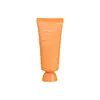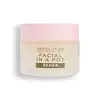What's inside
What's inside
 Key Ingredients
Key Ingredients

 Benefits
Benefits

 Concerns
Concerns

 Ingredients Side-by-side
Ingredients Side-by-side

Water
Skin ConditioningButylene Glycol
HumectantGlycerin
HumectantCetyl Ethylhexanoate
Emollient1,2-Hexanediol
Skin ConditioningSqualane
EmollientButyrospermum Parkii Butter
Skin ConditioningDi-C12-13 Alkyl Malate
EmollientCyclopentasiloxane
EmollientDimethicone
EmollientGlyceryl Stearate
EmollientCyclohexasiloxane
EmollientTrehalose
HumectantC14-22 Alcohols
Emulsion StabilisingPalmitic Acid
EmollientStearic Acid
CleansingCetearyl Alcohol
EmollientHydrogenated Castor Oil Isostearate
Skin ConditioningHydroxypropyl Starch Phosphate
PEG-100 Stearate
Dimethicone/Vinyl Dimethicone Crosspolymer
Skin ConditioningC12-20 Alkyl Glucoside
EmulsifyingPolyacrylate-13
Phytosteryl/Behenyl/Octyldodecyl Lauroyl Glutamate
Skin ConditioningC12-16 Alcohols
EmollientAcrylates/C10-30 Alkyl Acrylate Crosspolymer
Emulsion StabilisingTromethamine
BufferingParfum
MaskingXanthan Gum
EmulsifyingZiziphus Jujuba Fruit Extract
Skin ConditioningGlyceryl Caprylate
EmollientJuglans Regia Seed Extract
Skin ConditioningLimonene
PerfumingPolyisobutene
Scutellaria Baicalensis Root Extract
AstringentHydrogenated Lecithin
EmulsifyingMorus Alba Root Extract
BleachingDisodium EDTA
Ethylhexylglycerin
Skin ConditioningDextrin
AbsorbentTheobroma Cacao Extract
Skin ConditioningHoney
HumectantLinalool
PerfumingPolysorbate 20
EmulsifyingNelumbo Nucifera Flower Extract
Skin ConditioningPolygonatum Officinale Rhizome/Root Extract
Skin ConditioningRehmannia Glutinosa Root Extract
Skin ConditioningPaeonia Albiflora Root Extract
Skin ConditioningLilium Candidum Bulb Extract
Skin ConditioningSorbitan Isostearate
EmulsifyingPanax Ginseng Root Extract
EmollientPunica Granatum Fruit Extract
AntioxidantPropanediol
SolventCitronellol
PerfumingCitral
PerfumingGeraniol
PerfumingMyristic Acid
CleansingArachidic Acid
CleansingGlucose
HumectantBenzyl Benzoate
AntimicrobialGlycyrrhiza Uralensis Root Extract
Skin ConditioningTocopherol
AntioxidantPunica Granatum Flower Extract
Skin ConditioningWater, Butylene Glycol, Glycerin, Cetyl Ethylhexanoate, 1,2-Hexanediol, Squalane, Butyrospermum Parkii Butter, Di-C12-13 Alkyl Malate, Cyclopentasiloxane, Dimethicone, Glyceryl Stearate, Cyclohexasiloxane, Trehalose, C14-22 Alcohols, Palmitic Acid, Stearic Acid, Cetearyl Alcohol, Hydrogenated Castor Oil Isostearate, Hydroxypropyl Starch Phosphate, PEG-100 Stearate, Dimethicone/Vinyl Dimethicone Crosspolymer, C12-20 Alkyl Glucoside, Polyacrylate-13, Phytosteryl/Behenyl/Octyldodecyl Lauroyl Glutamate, C12-16 Alcohols, Acrylates/C10-30 Alkyl Acrylate Crosspolymer, Tromethamine, Parfum, Xanthan Gum, Ziziphus Jujuba Fruit Extract, Glyceryl Caprylate, Juglans Regia Seed Extract, Limonene, Polyisobutene, Scutellaria Baicalensis Root Extract, Hydrogenated Lecithin, Morus Alba Root Extract, Disodium EDTA, Ethylhexylglycerin, Dextrin, Theobroma Cacao Extract, Honey, Linalool, Polysorbate 20, Nelumbo Nucifera Flower Extract, Polygonatum Officinale Rhizome/Root Extract, Rehmannia Glutinosa Root Extract, Paeonia Albiflora Root Extract, Lilium Candidum Bulb Extract, Sorbitan Isostearate, Panax Ginseng Root Extract, Punica Granatum Fruit Extract, Propanediol, Citronellol, Citral, Geraniol, Myristic Acid, Arachidic Acid, Glucose, Benzyl Benzoate, Glycyrrhiza Uralensis Root Extract, Tocopherol, Punica Granatum Flower Extract
Water
Skin ConditioningGlycerin
HumectantPropanediol
SolventAcetyl Hexapeptide-8
HumectantCeramide AP
Skin ConditioningCeramide EOP
Skin ConditioningCeramide NP
Skin ConditioningCholesterol
EmollientPhytosphingosine
Skin ConditioningPolyglyceryl-4 Laurate/Sebacate
SolventPolyglyceryl-6 Caprylate/Caprate
StabilisingCaramel
Cosmetic ColorantCarbomer
Emulsion StabilisingSodium Lauroyl Lactylate
EmulsifyingXanthan Gum
EmulsifyingTetrasodium Glutamate Diacetate
Caprylyl Glycol
EmollientEthylhexylglycerin
Skin ConditioningSodium Hydroxide
BufferingCitric Acid
BufferingPhenoxyethanol
PreservativeParfum
MaskingWater, Glycerin, Propanediol, Acetyl Hexapeptide-8, Ceramide AP, Ceramide EOP, Ceramide NP, Cholesterol, Phytosphingosine, Polyglyceryl-4 Laurate/Sebacate, Polyglyceryl-6 Caprylate/Caprate, Caramel, Carbomer, Sodium Lauroyl Lactylate, Xanthan Gum, Tetrasodium Glutamate Diacetate, Caprylyl Glycol, Ethylhexylglycerin, Sodium Hydroxide, Citric Acid, Phenoxyethanol, Parfum
Ingredients Explained
These ingredients are found in both products.
Ingredients higher up in an ingredient list are typically present in a larger amount.
Ethylhexylglycerin (we can't pronounce this either) is commonly used as a preservative and skin softener. It is derived from glyceryl.
You might see Ethylhexylglycerin often paired with other preservatives such as phenoxyethanol. Ethylhexylglycerin has been found to increase the effectiveness of these other preservatives.
Glycerin is already naturally found in your skin. It helps moisturize and protect your skin.
A study from 2016 found glycerin to be more effective as a humectant than AHAs and hyaluronic acid.
As a humectant, it helps the skin stay hydrated by pulling moisture to your skin. The low molecular weight of glycerin allows it to pull moisture into the deeper layers of your skin.
Hydrated skin improves your skin barrier; Your skin barrier helps protect against irritants and bacteria.
Glycerin has also been found to have antimicrobial and antiviral properties. Due to these properties, glycerin is often used in wound and burn treatments.
In cosmetics, glycerin is usually derived from plants such as soybean or palm. However, it can also be sourced from animals, such as tallow or animal fat.
This ingredient is organic, colorless, odorless, and non-toxic.
Glycerin is the name for this ingredient in American English. British English uses Glycerol/Glycerine.
Learn more about GlycerinParfum is a catch-all term for an ingredient or more that is used to give a scent to products.
Also called "fragrance", this ingredient can be a blend of hundreds of chemicals or plant oils. This means every product with "fragrance" or "parfum" in the ingredients list is a different mixture.
For instance, Habanolide is a proprietary trade name for a specific aroma chemical. When used as a fragrance ingredient in cosmetics, most aroma chemicals fall under the broad labeling category of “FRAGRANCE” or “PARFUM” according to EU and US regulations.
The term 'parfum' or 'fragrance' is not regulated in many countries. In many cases, it is up to the brand to define this term.
For instance, many brands choose to label themselves as "fragrance-free" because they are not using synthetic fragrances. However, their products may still contain ingredients such as essential oils that are considered a fragrance by INCI standards.
One example is Calendula flower extract. Calendula is an essential oil that still imparts a scent or 'fragrance'.
Depending on the blend, the ingredients in the mixture can cause allergies and sensitivities on the skin. Some ingredients that are known EU allergens include linalool and citronellol.
Parfum can also be used to mask or cover an unpleasant scent.
The bottom line is: not all fragrances/parfum/ingredients are created equally. If you are worried about fragrances, we recommend taking a closer look at an ingredient. And of course, we always recommend speaking with a professional.
Learn more about ParfumPropanediol is an all-star ingredient. It softens, hydrates, and smooths the skin.
It’s often used to:
Propanediol is not likely to cause sensitivity and considered safe to use. It is derived from corn or petroleum with a clear color and no scent.
Learn more about PropanediolWater. It's the most common cosmetic ingredient of all. You'll usually see it at the top of ingredient lists, meaning that it makes up the largest part of the product.
So why is it so popular? Water most often acts as a solvent - this means that it helps dissolve other ingredients into the formulation.
You'll also recognize water as that liquid we all need to stay alive. If you see this, drink a glass of water. Stay hydrated!
Learn more about WaterXanthan gum is used as a stabilizer and thickener within cosmetic products. It helps give products a sticky, thick feeling - preventing them from being too runny.
On the technical side of things, xanthan gum is a polysaccharide - a combination consisting of multiple sugar molecules bonded together.
Xanthan gum is a pretty common and great ingredient. It is a natural, non-toxic, non-irritating ingredient that is also commonly used in food products.
Learn more about Xanthan Gum